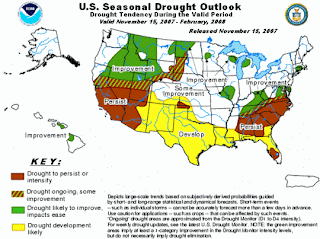The idea has been raised several times in the 25 years I've lived in Marin County, but this time there seems to be much more resolve around it - to build a desalination plant to provide potable water to supplement the county's watershed-collected source.
We've been through dry periods here since 1983; I distinctly remember a 7-year period spanning the late '80s and early '90s when low-volume showerheads were distributed and we all put bricks or filled plastic containers in our toilet tanks to conserve water. If we don't get at least our average rainfall this winter, we'll certainly be facing a water shortage next summer.
According to the drought forecast map maintained by the U.S. Government's National Integrated Drought Information System (NIDIS) , Marin County sits near the northern boundary of the "persistent drought" region in the American Southwest. Just north of us is the region labeled "dought ongoing, some improvement."
The prospects look threatening enough that the Marin Municipal Water District (MMWD) has released a report to begin the environmental impact study of the various energy sources required to power the plant. The project is proposed to roll out in three progressive stages, each adding 5 million gallons a day to the county's supply. In addition to adding water, the project adds substantionally to the county's energy needs.
The energy requirements summarized in Table 1 indicate that the projected electricity demand for operation of a new desalination plant will be substantial, representing an 85%, 162% and 246% increase above current MMWD electricity needs for the 5 mgd, 10 mgd and 15 mgd capacity phases, respectively.The county is considering many alternative energy sources, from methane harvested at the county landfill to photovoltaic arrays and even tidal energy generators. This could be a good test case of how fast adaptation planning can progress at this time, when a crisis may be looming within the next year. We've got the situation in Georgia staring us in the face - a stark illustration of what happens to a region without a backup plan for drought.
Even in the best case scenario, Marin won't be harvesting potable water from the San Francisco Bay in time to alleviate a water shortage in 2008. But will there be enough public support to fast-track this alternative water supply? Or will the project entail too many environmental questions and compromises to gain the support of Marin's varied constituencies?


No comments:
Post a Comment